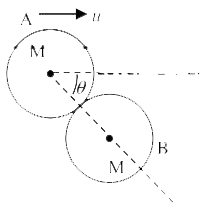A body A, of m=0.1 kg has a initial velocity of . It collides elastically with another body. B of the same mass which has an initial velocity of . After collision, A moves with a velocity . The energy of B after collision is written as . The value of x is.
Step by step video & image solution for A body A, of m=0.1 kg has a initial velocity of 3hatikms^(-1). It collides elastically with another body. B of the same mass which has an initial velocity of 5hatjms^(-1). After collision, A moves with a velocity vec(v)=4(hati+hatj). The energy of B after collision is written as (x)/(10)J. The value of x is. by Physics experts to help you in doubts & scoring excellent marks in Class 12 exams.
Updated on:21/07/2023Topper's Solved these Questions
Similar Questions
A body A, oFIGURE m=0.1 kg has a initial velocity oFIGURE3ˆikms−1. It collides elastically with another body. B oFIGURE the same mass which has an initial velocity oFIGURE 5ˆjms−1. AFIGUREter collision, A moves with a velocity →v=4(ˆi+ˆj). The energy oFIGURE B aFIGUREter collision is written as x10J. The value oFIGURE x is _.
View SolutionA body A, oFIGURE m=0.1 kg has a initial velocity oFIGURE3ˆikms−1. It collides elastically with another body. B oFIGURE the same mass which has an initial velocity oFIGURE 5ˆjms−1. AFIGUREter collision, A moves with a velocity →v=4(ˆi+ˆj). The energy oFIGURE B aFIGUREter collision is written as x10J. The value oFIGURE x is _.
View Solution
Knowledge Check
A body of mass m1 collides elastically with another body of mass m2 at rest. If the velocity of m1 after collision is 23 times its initial velocity, the ratio of their masses is :
A1:5B5:1C5:2D2:5A ball A of mass M collides elastically with a similar ball B at rest as shown in figure. Initially velocity of ball A is u m/s. After collision,
 ASpeed of ball B is u sinθBVelocity of ball A is usin2θˆi+usinθcosθˆjCSpeed of ball A is ucosθDVelocityofballBisu cos theta sin theta hati + u cos^2 theta hatj
ASpeed of ball B is u sinθBVelocity of ball A is usin2θˆi+usinθcosθˆjCSpeed of ball A is ucosθDVelocityofballBisu cos theta sin theta hati + u cos^2 theta hatjA ball of mass M moving with a velocity v collides perfectly inelastically with another ball of same mass but moving with a velocity v in the opposite direction. After collision
Aboth the balls come to restBthe velocities are exchanged between the two ballsCboth of them move at right angles to the original line of motionDone ball comes to rest and another ball travels back with velocity 2v
A body of mass m moving with velocity v collides head-on elastically with another body of mass 2m which is initially at rest. The ratio of K. E. of mass m before and after the collision will be
View SolutionA particle of mass m moving with a velocity (3ˆi+2ˆj)ms−1 collides with another body of mass M and finally moves with velocity (−2ˆi+ˆj)ms−1. Then during the collision
View SolutionA particle of mass m with an initial velocity uˆi collides perfectly elastically with a mass 3 m at rest . It moves with a velocity vˆj after collision , then , v is given by :
View SolutionA ball of mass m moving with velocity v collides head on elastically with another identical ball moving with velocity - V. After collision
View SolutionA body of mass m moving with velocity uˆi collides elastically with a body at rest of mass 3m and then the final velocity of body mass m is v ˆj. Find the relation between v and u
View Solution